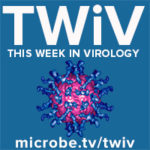Matt Frieman returns to TWiV to discuss the COVID-19 pandemic from the point of view of a coronavirologist, including his work with Novavax on their spike protein-based vaccine.
Hosts: Vincent Racaniello, Dickson Despommier, Rich Condit, Kathy Spindler, and Brianne Barker
Guest: Matt Frieman
Click arrow to play
Download TWiV 729 (70 MB .mp3, 117 min)
Subscribe (free): iTunes, Google Podcasts, RSS, email
Become a patron of TWiV!
Links for this episode
- Phase 1-2 trial of Novavax protein vaccine (NEJM) 33:12
- MERS-CoV spike nanoparticle vaccine in mice (Vaccine) 12:52
- Novavax phase 3 press release 31:38
- When you’ve been fully vaccinated (CDC) 1:26:59
- Letters read on TWiV 729 59:02
- Timestamps by Jolene. Thanks!
Weekly Picks 1:43:29
Dickson – Covid-19 deaths per million ranked by average income
Brianne – KFF COVID-19 Vaccine Monitor for Feb 2021 and KFF COVID-19 Vaccine Monitor Dashboard
Rich – The Woman Who Stood Between America and a Generation of ‘Thalidomide Babies’ (wiki)
Kathy – Quadrantid meteor (Quadrantids)
Vincent – Higher Superstition by Paul Gross and Norman Levitt
Intro music is by Ronald Jenkees
Send your virology questions and comments to [email protected]


The youtube link points to TWiV 728 and not to TWiV 729. The MP3 link is correct.
Dear TWIV,
In this episode there was a passing mention of the term “apoptosis” and the fact that there are many ways of pronouncing the term. I just so happen to keep on my desktop the original article that coined the term:
https://www.ncbi.nlm.nih.gov/pmc/articles/PMC2008650/
In a brief footnote on page 241, the article actually addresses the pronunciation
issue and it’s a pronunciation that I NEVER heard an instructor or medical professional use.
The correct pronunciation is ap-toe-sis with the accent on the penultimate syllable. This makes sense if you consider “ptosis”, a commonly used medical term in which the “p” is silent.
In any case, I hope you will find this interesting given the almost universal incorrectness in the medical and scientific world.
Regards,
Kermit Hummel
The discussion on the early treatment with Remdesivir and mAbs sadly did not get into diagnostics which I view as the neglected arm of the diagnostic, vaccines and therapeutics troika. It also became obvious in attempts to ring fence zoonotic influenza outbreaks that regardless of how good an antiviral you have it is not going to do much good if you do not have a rapid point-of-care diagnostic to go along with it. Mina and TWiV have fought the good fight in this pandemic but the absence of a regulatory framework allowing for public health, rather than therapeutic, diagnostics approval must be a priority in its aftermath if we are not going to have the same problem in future zoonotic outbreaks.
I would be grateful if Vincent could consider, when he views the time is right, to try and get a guest who could throw light on the risks and possible hosts for establishment of a reverse-zoonosis reservoir. This seems to be a bigger potential long term problem with this virus than the extant bat Sarbeco gene pool.
Many thanks for all the Microbe.tv shows and all the hosts and guests.
Dear Vincent and TWIV group,
You raised important points about the term “virion” in your discussion in TWIV 729, but missed another important point. Yes, as you noted, virion is distinct from virus particle because virion is the infectious unit, and defective-interfering particles, etc., are excluded. But the term virion is especially important to plant virologists because in many cases, a complete infections virus (=virion) comprises more than one particle. Unlike animal viruses, in which individual RNA or DNA segments of divided genomes are almost always encapsidated together in a single particle (e.g., influenza and many others), plant viruses with divided RNA or DNA genomes often encapsidate those segments in separate particles. Well-studied examples include Brome mosaic virus (the virion comprising three icosahedral particles) or Barley stripe mosaic virus (the virion comprising three rod-shaped particles). So in many plant viruses, RNA or DNA segments encoding the replicase, the capsid protein, and the protein required for cell-to-cell movement may be encapsidated separately and travel separately as components of the complete virion in such viruses. Other similar arrangements as well.
Keep up the great work,
Brad Hillman
Plant Biology, Rutgers